The Evaluation Method of the Marine Spatial Suitability for Islands from the Perspective of Sustainable Development: A Case Study of the Pingtan Islands
Abstract
:1. Introduction
2. Literature Review
3. Date and Methods
3.1. Study Area and Date
3.2. Methods
3.2.1. Classification of the Sea Area Space around the Islands
- (1)
- Marine construction space
- (2)
- Marine agricultural production space
- (3)
- Marine ecological space
3.2.2. Construction of the Spatial Suitability Evaluation Index System
- (1)
- Evaluation indexes and weights
- (2)
- Measurement of the index data
- 1)
- Marine resources evaluation
The marine resources evaluation indexes (Z) included the resource effect index and the development effect index, which were mainly used to characterize the different levels of comprehensive influence on the marine space resources by different types of sea areas, and its formula was as follows:where is the marine resource effect index, is the development effect index, is the weight of the marine resource effect index and is the weight of development effect index .The marine resource effect index was evaluated based on the effect of marine development activities in the main functional marine areas for marine space resources. Referring to the technical method in the Monitoring and Early-warning Technical Methods of Resources and Environment Carrying Capacity (Trial) [25], consumption coefficients of different types of functional areas for marine space resources were established, as shown in Table 2. The formula for calculating the marine resource effect index () was as follows:where is the number of marine functional area types, is the consumption coefficient of the ith marine functional area, is the area of the ith marine functional area and is the total area.The development effect index was evaluated based on the area of various sea activities and influence weight to construct the spatial influence coefficients of different sea activities, as shown in Table 3. The formula for the development effect index () was as follows:where is the number of marine functional area types, is the consumption coefficient of the ith marine functional area, is the area of the ith marine functional area and is the total area.- 2)
- Evaluation of the marine environment
As the carrier of the marine ecosystem, seawater is crucial for maintaining the health of marine ecology [81]. Pollutions caused by seawater eutrophication, oil spills, and seawater exploration and development can be reflected through water quality indexes. The Bulletin of Marine Ecology and Environment Status of China reflects the state of the marine ecological environment primarily through water quality. Therefore, the marine environment evaluation index was mainly measured using the sea area water quality, and the data were obtained from the local marine environment monitoring data.- 3)
- Evaluation of the marine space resources
The evaluation of the marine biological resources was characterized by the shoreline and sea area development intensity, and was calculated using the following formula:where is the number of types of shorelines (sea area), represents the length (area) of the ith developed shoreline (sea area) and is the total length (area) of shoreline (sea area).- 4)
- Evaluation of the marine biological resources
The evaluation of marine biological resources mainly considered the number of individuals of phytoplankton, zooplankton and benthos, as well as the changes in marine ecological protection objects, and was obtained using the marine biodiversity carrying index and change rate of marine ecological protection objects. The marine biodiversity change index combined the phytoplankton index, zooplankton index and benthos index. Among them, the number of species reflected the species richness of phytoplankton, zooplankton and benthic communities within a unit, the density reflected the total number of organisms per unit volume within a unit, and the species diversity index reflected the distribution of species richness and number of individuals in the biological community.The evaluation index of the marine biological resources () was calculated by averaging the weight of the single index evaluation results of the phytoplankton index (), zooplankton index () and benthos index (), and the formula was as follows:When < 1.5, marine ecology will be overloaded; when 1.5 ≤ < 2.5, marine ecology will be critically overloaded; when ≥ 2.5, the marine ecology will be loadable.The phytoplankton index was calculated with the monitoring data of shallow water type III net phytoplankton in the marine biodiversity/ecological monitoring area as follows:where is the change in phytoplankton; and are the density and the number of species of phytoplankton in the past decade, respectively; and the number of species is the total population of different biological species in the evaluation unit. The density is the average annual biological density of each monitoring station divided by the number of stations in the evaluation unit.The zooplankton index was calculated with the net monitoring data of type I zooplankton in the marine biodiversity or ecological monitoring area as follows:where is the change in zooplankton, and and are the zooplankton density and the changes in the current value and average value of the number of species in the past decade respectively.The benthos index was calculated with the quantitative monitoring data of macrobenthos in the marine biodiversity or ecological monitoring area as follows:where is the change in benthos, and and are the density and number of benthos species and the changes in the current value and average value of species diversity index, respectively.When > 50%, the changes are significant, and the value is 1. When 25% < ≤ 50%, fluctuation appears and the value is 2. When ≤ 25%, it is largely stable and the value is 3.- 5)
- Dominance of the maritime traffic
Since islands have a small spatial scale, the closest distance from the grid center point in the evaluation unit to the shoreline was taken as a measure of the marine traffic dominance. In addition, the evaluation results were categorized into five levels with the assignments shown in Table 4.
3.2.3. Calculation and Classification of the Evaluation Unit
3.2.4. Determination Method for the Three Types of Space
- (1)
- In the evaluation results of marine space zoning, only one area with a high degree of suitability will be divided into this type of space. Under the principle of ecological priority, two areas with a high degree of suitability, including one with a high degree of suitability for marine ecology suitability, will be classified into a marine ecological space. Otherwise, it will be classified as a marine agricultural production space according to the priority principle. If all three suitability levels are high, it can be classified as a marine ecological space according to the principle of ecological priority.
- (2)
- For the divided areas above, if the marine ecology suitability or the agriculture and fishery production suitability in the evaluation results of marine space zoning suitability are medium, they will be divided into this type of space. When both are medium, the type of space with low suitability in the main functional orientation can be determined based on the priority of the marine ecological space, marine agricultural production space and marine construction space. As an alternative, the concentration of space types can be determined according to the principle of space concentration. Otherwise, it will be divided into the space type consistent with its main functional orientation according to the principle of implementing the main functional orientation. If all three suitability levels are medium, the area will be divided into the space type consistent with its main functional orientation under the principle of main functional orientation. If all three suitability levels are low, it can be divided into a marine ecological space under the principle of ecological protection priority.
4. Results
4.1. Single Evaluation of the Important First-Level Indexes
4.1.1. Evaluation Results for the Marine Resources
- (1)
- According to the characteristics of the marine environment and its natural resources, the status of marine exploration and development, and the strategic demand for environmental protection and economic development, the Pingtan marine functional areas were classified into eight types. Among them are agriculture and fishery areas, port shipping areas, industrial and town sea areas, mineral and energy areas, tourism, leisure and recreational areas, marine protected areas, special utilization areas and reserved areas. Furthermore, there were 31 basic functional areas in total [88].
- (2)
- (3)
4.1.2. Evaluation Results for the Marine Environment
4.1.3. Evaluation Results for the Marine Biological Resources
4.2. Suitability Evaluation
4.2.1. Evaluation Results for the Marine Ecological Suitability
4.2.2. Suitability Evaluation Results for the Marine Agricultural Production
4.2.3. Suitability Evaluation Results for the Marine Town Construction
4.3. Results of the Suitability Zoning
5. Discussion
6. Conclusions
Author Contributions
Funding
Institutional Review Board Statement
Informed Consent Statement
Data Availability Statement
Conflicts of Interest
References
- Chen, Q.; Dong, H. Sustainable development indicator systems for island cities: The case of Zhoushan Maritime Garden City. Isl. Stud. J. 2019, 14, 137–156. [Google Scholar] [CrossRef]
- Liu, J.Y.; Dou, S.Q.; Li, Q.H.; Zhang, J. Research of Water Resources and Environment Carrying Capacity of Island. Ecol. Econ. 2019, 35, 130–135+184. [Google Scholar]
- Kim, S.P. Mainland development policy in an autonomous subnational island jurisdiction: Spatial development and economic dependence in Jeju, South Korea. Isl. Stud. J. 2019, 15, 1. [Google Scholar] [CrossRef]
- Wu, Y.B.; Fu, S.F.; Wu, H.Y.; Chen, F.G.; Cai, X.Q.; Yu, W.W.; Wu, J.; Pan, X. Study on the evaluation of development and utilization intensity of uninhabited islands and geographical influencing factors in Fuzhou. China Environ. Sci. 2023, 1–11. [Google Scholar] [CrossRef]
- Chi, Y.; Liu, D.H.; Wang, C.J.; Xing, W.X.; Gao, J.H. Island development suitability evaluation for supporting the spatial planning in archipelagic areas. Sci. Total Environ. 2022, 829. [Google Scholar] [CrossRef]
- Fugate, G. Emerging Issue: Coastal and Marine Spatial Planning: Rhode Island’s Ocean Special Area Management Plan: Leading the Way for the Nation. Yakugaku Zasshi. J. Pharm. Soc. Jpn. 2012, 90, 716–723. [Google Scholar]
- Ji, X.P.; Huang, X.J.; Chen, Y.; Wang, D.Y.; Song, Y.Y. Comprehensive suitability evaluation of spatial development and construction land in the perspective of land-ocean co-ordination: A case study of Liaoning province, China. J. Nat. Resour. 2019, 34, 451–463. [Google Scholar] [CrossRef]
- Feng, Y.; Zheng, Z. Suitability Evaluation of Ningbo Marine Tourism Recreation and Improvement of Functional Zoning. Ocean Dev. Manag. 2017, 34, 92–96. [Google Scholar]
- Matsubayashi, J.; Otsubo, K.; Morimoto, J.O.; Nakamura, F.; Nose, T.; Tayasu, I. Feeding habits may explain the morphological uniqueness of brown bears on Etorofu Island, Southern Kuril Islands in East Asia. Biol. J. Linn. Soc. 2016, 119, 1. [Google Scholar] [CrossRef] [Green Version]
- Silvia, S.b.; Muhammad, H.H.; Erlangga, R. The Uniqueness of The Marketing System of Maicih Chips The Marketing Analysis of Cassava Chips in Indonesia. In Proceedings of the 2012 International Conference on Economics, Business and Marketing Management CEBMM, Singapore, 26–28 February 2012. [Google Scholar]
- Ginting, N. The uniqueness of the environmental aspects of sustainable tourism on Samosir Island. IOP Conf. Ser. Earth Environ. Sci. 2020, 452, 012120. [Google Scholar] [CrossRef]
- Qi, Y.; Ma, G.B.; Kang, J.; Wu, N.; Bao, C.G.; Du, Y. Evaluation of resource and environment carrying capacity of uninhabited island—A case study of the Bohai Sea. Mar. Environ. Sci. 2022, 41, 129–134+141. [Google Scholar] [CrossRef]
- Li, L.; Ma, Y.C. A Review and Future Agenda for Marine Island Ecological Vulnerability Research. Ocean Dev. Manag. 2018, 35, 60–67. [Google Scholar]
- Zhang, K.C.; Guo, X.C.; Guo, P.F.; Shi, M.C.; Shi, H.Y.; Tian, S.Z. Evaluate the development potential of islands from the perspective of resources and natural environment—Using seven island counties(districts) as examples. Mar. Environ. Sci. 2022, 41, 230–235. [Google Scholar] [CrossRef]
- Han, Z.L.; Cai, X.Z.; Guo, J.K. Contribution Rate of Science and Technology Progress in Coastal Provinces Based on Perspective of Land-sea Coordination. Areal Res. Dev. 2019, 38, 19–24. [Google Scholar] [CrossRef]
- Singh, G.G.; Cottrell, R.S.; Eddy, T.D.; Cisneros-Montemayor, A.M. Governing the land-sea interface to achieve sustainable coastal development. Front. Mar. Sci. 2021, 8, 709947. [Google Scholar] [CrossRef]
- Liu, D.; Xing, W. Analysis of China’s coastal zone management reform based on land-sea integration. Mar. Econ. Manag. 2019, 2, 39–49. [Google Scholar] [CrossRef]
- Han, Z.L.; Di, Q.B.; Zhou, L.P. Discussion on the Connotation and Target of Sea-Land Coordination. Mar. Econ. 2012, 2, 10–15. [Google Scholar] [CrossRef]
- Schlüter, A.; Van Assche, K.; Hornidge, A.K.; Văidianu, N. Land-sea interactions and coastal development: An evolutionary governance perspective. Mar. Policy 2020, 112, 103801. [Google Scholar] [CrossRef]
- Wang, N.; Tian, X.H.; Wu, D.; Wu, N. The location-routing optimization for strategic delivery on maritime in land-sea coordination. Xitong Gongcheng Lilun Yu Shijian/Syst. Eng. Theory Pract. 2018, 38, 2929–2941. [Google Scholar] [CrossRef]
- O’Hagan, A.M.; Paterson, S.; Tissier, M.L. Addressing the tangled web of governance mechanisms for land-sea interactions: Assessing implementation challenges across scales. Mar. Policy 2019, 112, 103715. [Google Scholar] [CrossRef]
- Stephenson, R.L.; Hobday, A.J.; Cvitanovic, C.; Alexander, K.A.; Begg, G.A.; Bustamante, R.H.; Dunstan, P.K.; Frusher, S.; Fudge, M.; Fulton, E.A.; et al. A practical framework for implementing and evaluating integrated management of marine activities. Ocean Coast. Manag. 2019, 177, 127–138. [Google Scholar] [CrossRef]
- Asprogerakas, E.; Lazoglou, M.; Manetos, P. Assessing land–sea interactions in the framework of maritime spatial planning: Lessons from an ecosystem approach. Euro-Mediterr. J. Environ. Integr. 2020, 5, 1–14. [Google Scholar] [CrossRef]
- Lin, X.R.; Lv, Y.P.; Hong, S.J.; Wang, A.L. Measuring the Land-Sea Coupling Coordination Degree of the Coastal Zone and Its Optimization Strategy: A Case Study of the Coastal Zone in Xiamen. City Plan. Rev. 2022, 46, 54–62. [Google Scholar]
- Gao, J.Z.; An, T.t.; Shen, J.W.; Zhang, K.C.; Yin, Y.; Zhao, R.; He, G.S.; Stephen, H.; Ullah, J.Z. Development of a land-sea coordination degree index for coastal regions of China. Ocean Coast. Manag. 2022, 230, 106370. [Google Scholar] [CrossRef]
- Guo, J.; Wang, Z.; Yu, X. Accessibility measurement of China’s coastal ports from a land-sea coordination perspective—An empirical study. J. Transp. Geogr. 2022, 105, 103479. [Google Scholar] [CrossRef]
- Wang, C.; Chen, J.X.; Li, Z.W.; Nasr, E.S.A.; El-Tamimi, A.M. An indicator system for evaluating the development of land-sea coordination systems: A case study of Lianyungang port. Ecol. Indic. 2019, 98, 112–120. [Google Scholar] [CrossRef]
- Li, Z.Y.; Guo, Q.B. Research Hotspots and Prospects of Land-sea Coordination: Analysis of Knowledge Graph Based on Cite Space. J. South China Sea Stud. 2022, 8, 71–81. [Google Scholar]
- Jupiter, S.D.; Wenger, A.; Klein, C.J.; Albert, S.; Mangubhai, S.; Nelson, J.; Teneva, L.; Tulloch, V.J.; White, A.T.; Watson, J.E.M. Opportunities and constraints for implementing integrated land–sea management on islands. Environ. Conserv. 2017, 44, 254–266. [Google Scholar] [CrossRef] [Green Version]
- Harper, G.A.; Pahor, S.; Birch, D. The Lord Howe Island rodent eradication: Lessons learnt from an inhabited island. In Proceedings of the Vertebrate Pest Conference, Santa Barbara, CA, USA, 2–5 March 2020; Volume 29. [Google Scholar]
- Yue, W.Z.; Hou, B.; Ye, G.Q.; Wang, Z.W. China’s land-sea coordination practice in territorial spatial planning. Ocean Coast. Manag. 2023, 237, 106545. [Google Scholar] [CrossRef]
- Pittman, J.; Armitage, D. How does network governance affect social-ecological fit across the land–sea interface? An empirical assessment from the Lesser Antilles. Ecol. Soc. 2017, 22, 5. [Google Scholar] [CrossRef]
- Pittman, J.; Derek, A. Network governance of land-sea social-ecological systems in the Lesser Antilles. Ecol. Econ. 2019, 157, 61–70. [Google Scholar] [CrossRef]
- Partelow, S.; Nelson, K. Social networks, collective action and the evolution of governance for sustainable tourism on the Gili Islands, Indonesia. Mar. Policy 2020, 112. [Google Scholar] [CrossRef]
- Geng, J.; Yuan, M.S.; Xu, S.; Bai, T.T.; Xiao, Y.; Li, X.P.; Xu, D. Urban Expansion Was the Main Driving Force for the Decline in Ecosystem Services in Hainan Island during 1980–2015. Int. J. Environ. Res. Public Health 2022, 19, 15665. [Google Scholar] [CrossRef] [PubMed]
- Qin, K.Y.; Huang, H.J.; Liu, J.Y.; Yan, L.W.; Liu, Y.X.; Bi, H.B.; Zhang, Z.H.; Zhang, Y. Impact Mechanism of the Ecological Vulnerability of Highly Developed Islands Based on the Bayesian Network Model—Applied to the Changshan Islands. Int. J. Environ. Res. Public Health 2021, 18, 4150. [Google Scholar] [CrossRef] [PubMed]
- Zheng, W.H. Classified Development and Management Research of Islands Based on Ecological Suitability and Land-Sea Coordinating View; East China Normal University: Shanghai, China, 2020; pp. 13–17. [Google Scholar] [CrossRef]
- Liu, J.Y.; Ren, W.Z.; Zhang, J.; Mou, D.G. Research on Island Ecological Assets Valuation Based on Land and Sea Coordination: A Case Study of Weizhou Island in Guangxi. Ecol. Econ. 2021, 37, 32–37+43. [Google Scholar]
- Liu, X.B. Study on the Coordinate Development of Land and Sea in New District of Zhoushan Islands; Zhejiang Ocean University: Zhoushan, China, 2014; pp. 1–8. [Google Scholar]
- Huang, Q. Study on “Land-Sea Coordination” in the Construction of Hainan International Tourism Island; Hainan University: Haikou, China, 2019; pp. 4–20. [Google Scholar]
- Harris, L.R.; Bessinger, M.; Dayaram, A.; Holness, S.; Kirkman, S.; Livingstone, T.; Lombard, A.T.; Lück-Vogel, M.; Pfaff, M.; Sink, L.J.; et al. Advancing land-sea integration for ecologically meaningful coastal conservation and management. Biol. Conserv. 2019, 237, 81–89. [Google Scholar] [CrossRef]
- Zhou, D.J.; Xu, Y.; Wang, Y.F.; Zhou, K.; Liu, B.Y.; Li, J.Y.; Fan, J. Methodology and Role of “Double Evaluation” in Optimization of Spatial Development Pattern. Bull. Chin. Acad. Sci. 2020, 35, 814–824. [Google Scholar]
- Wang, Y.F.; Fan, J.; Zhou, K. Territorial function optimization regionalization based on the integration of “Double Evaluation”. Geogr. Res. 2019, 38, 2415–2429. [Google Scholar]
- Jia, K.J.; He, H.F.; Zhang, H.; Guo, J. Optimization of Territorial Space Pattern Based on Resources and Environment Carrying Capacity and Land Suitability Assessment. China Land Sci. 2020, 34, 43–51. [Google Scholar]
- Ma, R.F.; Ji, S.W.; Ma, J.W.; Zhu, B.Y.; Ren, L.Y.; Shao, Z.H. The Practice and Application of “Dual Evaluation” in Marine Areas: A Case of Wenzhou. Econ. Geogr. 2022, 42, 21–27. [Google Scholar]
- Liu, S.X.; Wang, W.P.; Sun, S.Y.; Chu, J.L.; Zhang, Y.H. Assessment method of development and utilization in uninhabited islands. Mar. Environ. Sci. 2013, 32, 783–786. [Google Scholar]
- Liu, B.L.; Zhang, Z.K.; Ji, X.P.; Jiang, S.N.; Wei, G.N.; Zhou, K.X.; Wang, P.Y. Research on suitability evaluation of land space development and functional space allocation in coastal zone: A case study of Hainan Island. J. Nat. Resour. 2022, 37, 862–879. [Google Scholar] [CrossRef]
- Li, Y.F.; Zhang, J.; Xiang, Z.Y.; Zhang, Z. Evaluation of marine space development suitability based on ecosystem service: A case study of Lingdingyang Bay of Guangdong-Hong Kong-Macao Greater Bay Area. J. Nat. Resour. 2022, 37, 999–1009. [Google Scholar] [CrossRef]
- Tian, Y.; Zeng, C.H.; Li, Z.Q.; Zhang, H.L. Evaluation of Marine Ecological Suitability for Development and Utilization of Offshore Areas in Qingdao. J. Guangdong Ocean Univ. 2021, 41, 17–22. [Google Scholar]
- Jiang, Q.Q.; Luo, X.X.; Zhang, L.J. Research on ecological suitability evaluation and thinking of its application in the marine environment. Mar. Environ. Sci. 2016, 35, 155–160. [Google Scholar]
- Xiang, Y.Y.; Yang, H.; Chen, P.X.; Zhou, X.; Chen, Q.Z.; Zeng, J.N. Management of marine ecosystem based on ecological suitability assessment with a case study in Dongtou district, Wenzhou city. J. Appl. Oceanogr. 2018, 37, 551–559. [Google Scholar]
- Ye, Z.C.; Sun, Y.; Gao, J.S.; Shen, Y.L. Suitability evaluation of exploitation and utilization in uninhabited islands—A case study in Liudun island of Fangchenggang city. Mar. Environ. Sci. 2018, 37, 843–848+856. [Google Scholar]
- Li, Y.S.; Huang, J.L.; Wang, C.; Wang, B.K.; Wu, H.J.; Zhang, J.W.; Lin, H.S.; Luo, H.H. Assessment of the Pingtan Islands land development suitability based on comprehensive ecological–economic–industrial analysis. Mar. Sci. 2017, 41, 1–10. [Google Scholar]
- Huang, P.; Chen, Y.; Zhang, Z.W.; Yan, W.W.; Zhao, J.X. Evaluation research on island spatial suitable zoning based on GIS: A case study on Lingshan Island. China Popul. Resour. Environ. 2016, 26, 145–148. [Google Scholar]
- An, T.T.; Gao, J.Z.; Li, J.; Zhu, Q.L.; Shen, J.W.; Ding, J. Functional zoning of coastal zone based on land-sea coordination—A case study of Ningbo. Mar. Sci. Bull. 2022, 41, 315–324. [Google Scholar]
- Lai, G.H.; Hu, B.Q.; Li, M.; Lin, S.G.; Deng, Y.F. Dynamic Changes of Ecological-Living-Production Land and Geographical Detect of Their Driving Forces in Southwest Guangxi-Beibu Gulf Zone. Res. Soil Water Conserv. 2021, 28, 236–243. [Google Scholar]
- Gao, J.Z.; Zhang, K.C.; He, G.S.; Tian, S.Z.; Zhao, Y.H. Study on the suitability of small-scale marine spatial planning—using Jinpu new district, Dalian as an example. Trans. Oceanol. Limnol. 2023, 45, 164–173. [Google Scholar] [CrossRef]
- Wang W J and Gong, H.B. Formation Mechanism of a Coastal Zone Environment Collaborative Governance Relationship: A Qualitative Comparative Analysis Based on fsQCA. Int. J. Environ. Res. Public Health 2022, 19, 11081. [Google Scholar] [CrossRef] [PubMed]
- Harris, F.R.; Knox, H.G. Important Considerations in Marine Construction. Trans. AIME 2013, 179, 40–51. [Google Scholar] [CrossRef]
- Wei, B.Q.; Li, Y.; Suo, A.N.; Zhang, Z.F.; Xu, Y.; Chen, Y.L. Spatial suitability evaluation of coastal zone, and zoning optimisation in Ningbo, China—ScienceDirect. Ocean Coast. Manag. 2020, 204, 105507. [Google Scholar] [CrossRef]
- Daniel, D.; Sten, H.H.; Lise, S.; Lena, B.; Giovanni, R.; Jeroen, S.; Magali, G.; Gonçalo, C.; Linus, H.; Jonas, P.; et al. Current status, advancements and development needs of geospatial decision support tools for marine spatial planning in European seas. Ocean. Coast. Manag. 2021, 209, 105644. [Google Scholar]
- Jia, S.; Li, C.L.; Xu, Z. Managing Navigation Channel Traffic and Anchorage Area Utilization of a Container Port. Transp. Sci. 2019, 53, 728–745. [Google Scholar] [CrossRef]
- Yan, S.W.; Jia, Z.L.; Liu, W.B.; Li, J. Research on the Large Diameter and Supper Long Pile Running under Self-Weight in the Ocean Engineering. J. Coast. Res. 2015, 73, 809–814. [Google Scholar] [CrossRef]
- Abe, S. The Policy for Future Action on Promotion of the Exploitation of Ocean Renewable Energies (Ocean Energy). J. Jpn. Inst. Energy 2013, 92, 232–235. [Google Scholar]
- Qu, J.G.; Yu, C.C.; Chen, Y.X. Screening, Fermentation and Isolation of Marine Bacteria against Agricultural Diseases and Fungi. J. Anhui Agric. Sci. 2019, 47, 140–142. [Google Scholar] [CrossRef]
- Zhang, X.Y.; Zhang, Y.Q.; Zhang, Q.; Liu, P.W.; Guo, R.; Jin, S.Y.; Liu, J.W.; Chen, L.; Ma, Z.; Liu, Y. Evaluation and Analysis of Water Quality of Marine Aquaculture Area. Int. J. Environ. Res. Public Health 2020, 17, 1446. [Google Scholar] [CrossRef] [PubMed] [Green Version]
- Yu, X.J.; Cui, W.L.; Deng, Y.C. The Development of Recreational Fishery in Island Industry: Taking Pingtan as An Example. Ocean Dev. Manag. 2017, 34, 112–117. [Google Scholar]
- Zhang, Y.N.; Chu, C.L.; Liu, L.; Xu, S.G.; Ruan, X.X.; Ju, M.T. Water Environment Assessment as an Ecological Red Line Management Tool for Marine Wetland Protection. Int. J. Environ. Res. Public Health 2017, 14, 870. [Google Scholar] [CrossRef] [Green Version]
- Long, R. The Marine Strategy Framework Directive: A new European approach to the regulation of the marine environment, marine natural resources and marine ecological services. J. Energy Nat. Resour. Law 2011, 29, 1–44. [Google Scholar] [CrossRef] [Green Version]
- Fox, N.; Marshall, J.; Dankel, D.J. Ocean literacy and surfing: Understanding how interactions in coastal ecosystems inform blue space user’s awareness of the ocean. Multidiscip. Digit. Publ. Inst. 2021, 11, 5819. [Google Scholar] [CrossRef] [PubMed]
- Cao, L.D.; Li, J.L.; Ye, M.T.; Pu, R.L.; Liu, Y.C.; Guo, Q.D.; Feng, B.X.; Song, X.Y. Changes of Ecosystem Service Value in a Coastal Zone of Zhejiang Province, China, during Rapid Urbanization. Int. J. Environ. Res. Public Health 2018, 15, 1301. [Google Scholar] [CrossRef] [PubMed] [Green Version]
- Dong, G.; Wang, J.; Zhang, W.; Liu, Z.; Wang, K.; Cheng, W. Land Use Conflict Identification Coupled with Ecological Protection Priority in Jinan City, China. Int. J. Environ. Res. Public Health 2023, 20, 4863. [Google Scholar]
- Wang, J.; Li, Y.; Wang, S.; Li, Q.; Li, L.; Liu, X. Assessment of Multiple Ecosystem Services and Ecological Security Pattern in Shanxi Province, China. Int. J. Environ. Res. Public Health 2023, 20, 4819. [Google Scholar] [CrossRef]
- Tang, L.; Long, H.; Aldrich, D.P. Putting a Price on Nature: Ecosystem Service Value and Ecological Risk in the Dongting Lake Area, China. Int. J. Environ. Res. Public Health 2023, 20, 4649. [Google Scholar] [CrossRef]
- Deng, Y.C. Study on the Talent Introduction Policy for the Sustainable Development of Islands. In Proceedings of the 1st International Symposium on Innovation and Education, Law and Social Sciences (IELSS 2019), Shenyang, China, 12–13 July 2019; pp. 304–308. [Google Scholar]
- Yu, X.J.; Cui, W.L.; Deng, Y.C.; Ying, X.L.; Liu, C.; Mei, Y.R. A study on the construction of a redline system for island ecological protection. Trans. Oceanol. Limnol 2017, 6, 115–121. [Google Scholar] [CrossRef]
- Xu, X.; Yang, G.; Yan, T. Identifying ecological red lines in China’s Yangtze River Economic Belt: A regional approach. Ecol. Indic. 2019, 96, 635–646. [Google Scholar] [CrossRef]
- Zhang, H.J.; Pang, Q.; Hua, Y.W.; Li, X.X.; Liu, K. Linking ecological red lines and public perceptions of ecosystem services to manage the ecological environment: A case study in the Fenghe River watershed of Xi’an. Ecol. Indic. 2020, 113, 106218. [Google Scholar] [CrossRef]
- Zou, C.X.; Xu, M.J.; Gao, J.X.; Yang, S.S. Ecological Security Evaluation of National Important Ecological Function Areas. J. Ecol. Rural. Environ. 2014, 30, 688–693. [Google Scholar]
- Gao, L.H.; Ning, J.; Bao, W.L.T.Y.; Yan, A.; Yin, Q.R. A study on the marine ecological security assessment of Guangdong-Hong Kong-Macao Great Bay Area. Mar. Pollut. Bull. 2022, 176, 113416. [Google Scholar] [CrossRef] [PubMed]
- Deng, Y. Study on Evaluation method of urban and rural construction land suitability. Nanjing Norm. Univ. 2008, 4–16. [Google Scholar] [CrossRef]
- Wang, X.L.; Jiang, G.Q.; Wang, J.L. Evaluation of coordinated development of marine environment-economy system based on multivariate statistical methods. Mar. Environ. Sci. 2015, 89, 106605. [Google Scholar]
- Rodriguez-Rodriguez, D.; Malak, D.A.; Soukissian, T.; Sanchez-Espinosa, A. Achieving blue growth through maritime spatial planning: Offshore wind energy optimization and biodiversity conservation in Spain. Mar. Policy 2016, 73, 8–14. [Google Scholar] [CrossRef]
- Chen, C.; Song, X.D.; Niu, X.Y. Discussion on Data Processing Method of Land Suitability Evaluation. Urban Plan. Int. 2015, 30, 70–77. [Google Scholar]
- Huang, H.; Chen, B.; Lin, J. The marine spatial classification and the identification of priority conservation areas (PCAs) for marine biodiversity conservation-A case study of the offshore China. Ocean Coast. Manag. 2015, 116, 224–236. [Google Scholar]
- Gao, J.Z.; Zhang, K.C.; He, G.S.; Wang, T.; Wei, X.L.; Shen, J.W. Reach on the technique method and demonstration of marine economic planning evaluation. Mar. Environ. Sci. 2019, 38, 114–122. [Google Scholar]
- Gao, J.Z. Study on the Technology of Marine Economic Planning; Ocean University of China: Qingdao, China, 2018; pp. 10–22. [Google Scholar]
- Shan, X.K. Methods for Environmental Quality Assessment of Marine Functional Areas. Sci. Technol. Vis. 2014, 3, 244–245. [Google Scholar] [CrossRef]
- Farmery, A.; Gardner, C.; Green, B.S.; Jennings, S. Managing fisheries for environmental performance: The effects of marine resource decision-making on the footprint of seafood. J. Clean. Prod. 2014, 64, 368–376. [Google Scholar] [CrossRef]
- Anderson, S.C.; Flemming, J.M.; Watson, R.; Lotze, H.K. Serial exploitation of global sea cucumber fisheries. Fish Fish. 2010, 12, 317–339. [Google Scholar] [CrossRef]
- Su, M.M.; Geoffrey, W.; Wu, B.l.; Xu, H.X.; Fu, X.H.; Deng, Y.C. Tourism place making through the bioluminescent “Blue Tears” of Pingtan Islands, China. Mar. Policy 2021, 133, 104744. [Google Scholar] [CrossRef]
- Banarsyadhimi Urai Ridho, A.M.F.; Dargusch, P.; Kurniawan, F. Assessing the Impact of Marine Tourism and Protection on Cultural Ecosystem Services Using Integrated Approach: A Case Study of Gili Matra Islands. Int. J. Environ. Res. Public Health 2022, 19, 12078. [Google Scholar] [CrossRef]
- Deng, Y.; Liu, X.; Gao, Y. On the “Meticulous Painting” of island ecotourism. Ocean Dev. Manag. 2020, 3, 10–15. [Google Scholar]
- Zhang, P.; Yu, H.; Shen, M.; Guo, W. Evaluation of tourism development efficiency and spatial spillover effect based on EBM model: The case of Hainan Island, China. Int. J. Environ. Res. Public Health 2022, 19, 3755. [Google Scholar] [CrossRef]
- Wen, X.; Ming, Y.; Gao, Y.; Hu, X. Dynamic monitoring and analysis of ecological quality of Pingtan comprehensive experimental zone, a new type of sea island city, based on RSEI. Sustainability 2019, 12, 21. [Google Scholar] [CrossRef] [Green Version]
- Santamouris, M. Recent progress on urban overheating and heat island research. Integrated assessment of the energy, environmental, vulnerability and health impact. Synergies with the global climate change. Energy Build. 2020, 207, 109482. [Google Scholar] [CrossRef]
- Kittipongvises, S.; Phetrak, A.; Rattanapun, P.; Brundiers, K.; Buizer, J.L.; Melnick, R. AHP-GIS analysis for flood hazard assessment of the communities nearby the world heritage site on Ayutthaya Island, Thailand. Int. J. Disaster Risk Reduct. 2020, 48, 101612. [Google Scholar] [CrossRef]
- Zhang, D.; Managi, S. Financial development, natural disasters, and economics of the Pacific small island states. Econ. Anal. Policy 2020, 66, 168–181. [Google Scholar] [CrossRef]
- Sarker, M.N.I.; Wu, M.; Alam, G.M.M.; Shouse, R.C. Livelihood vulnerability of riverine-island dwellers in the face of natural disasters in Bangladesh. Sustainability 2019, 11, 1623. [Google Scholar] [CrossRef] [Green Version]
- Connell, J. Islands: Balancing development and sustainability? Environ. Conserv. 2018, 45, 111–124. [Google Scholar] [CrossRef]
- Connell, J. Islands and Sustainability; Palgrave Macmillan: Cham, Switzerland, 2023; pp. 969–984. [Google Scholar] [CrossRef]

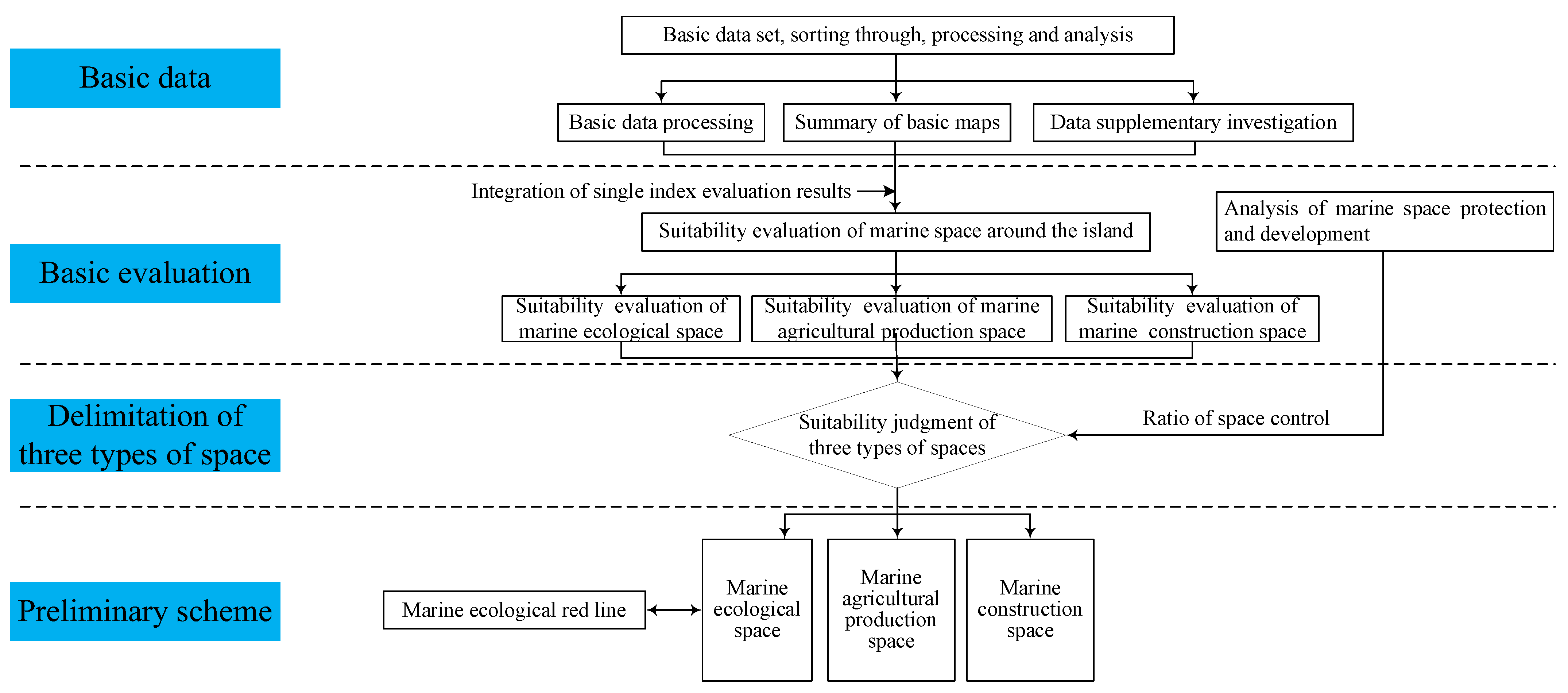

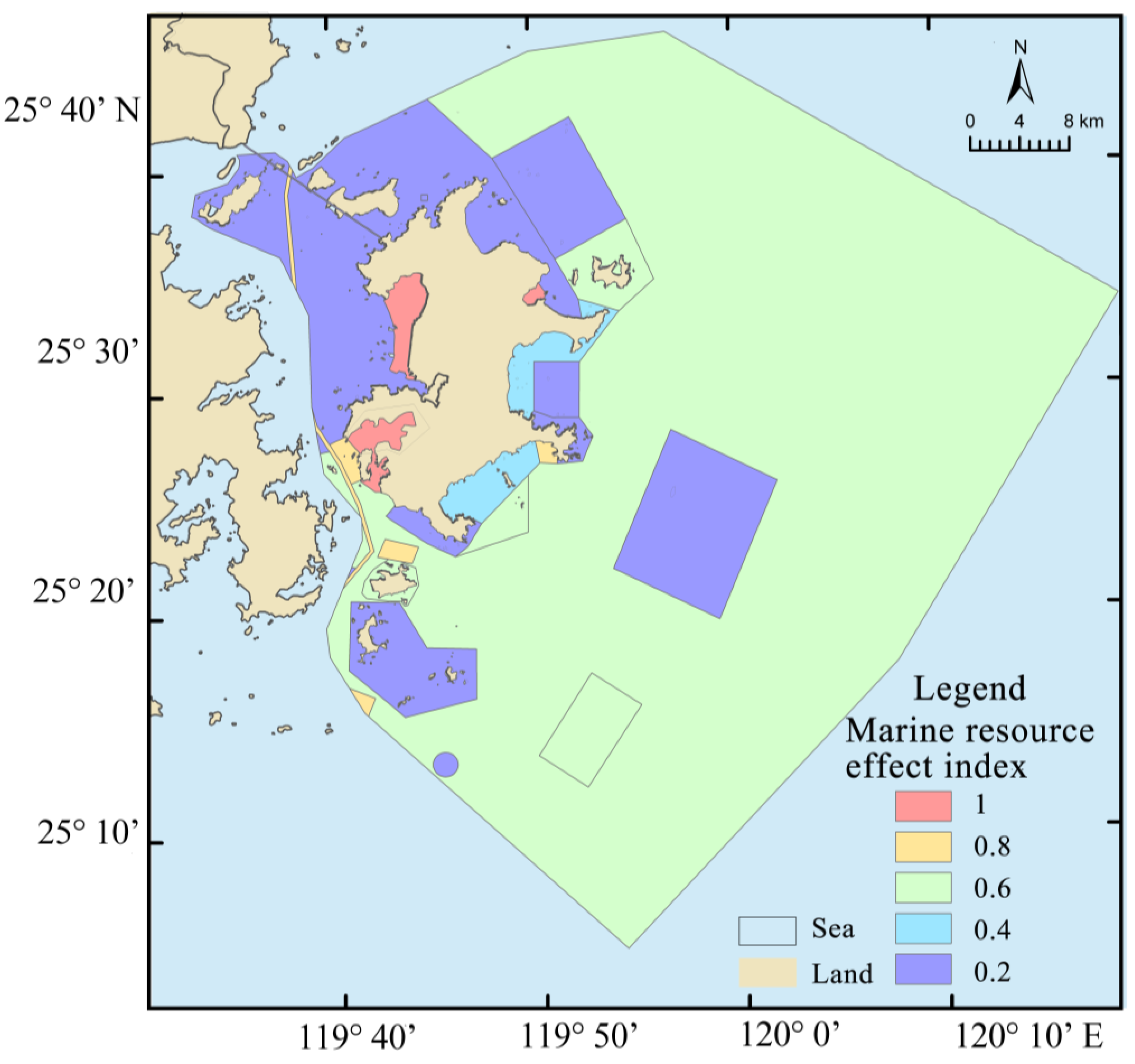
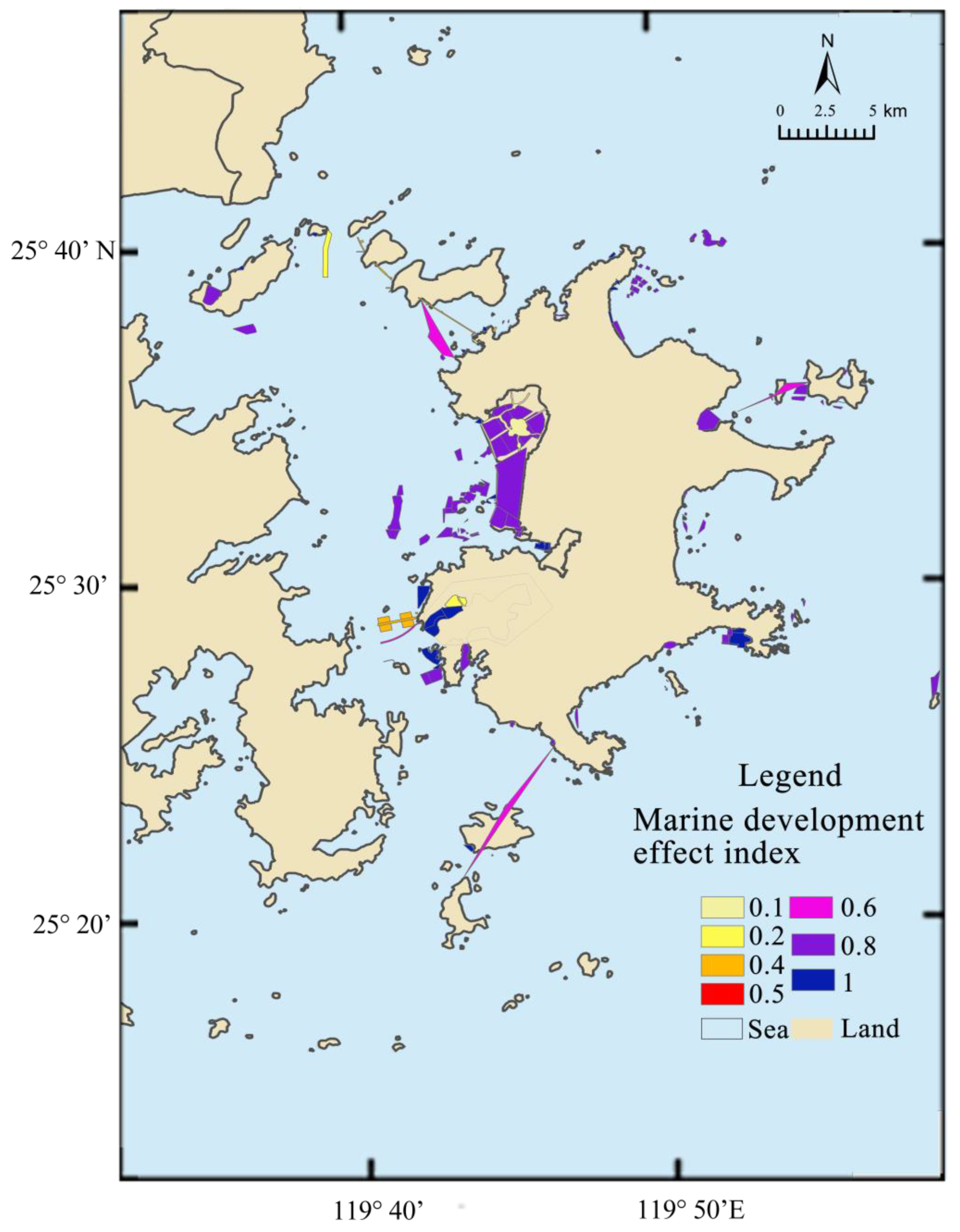
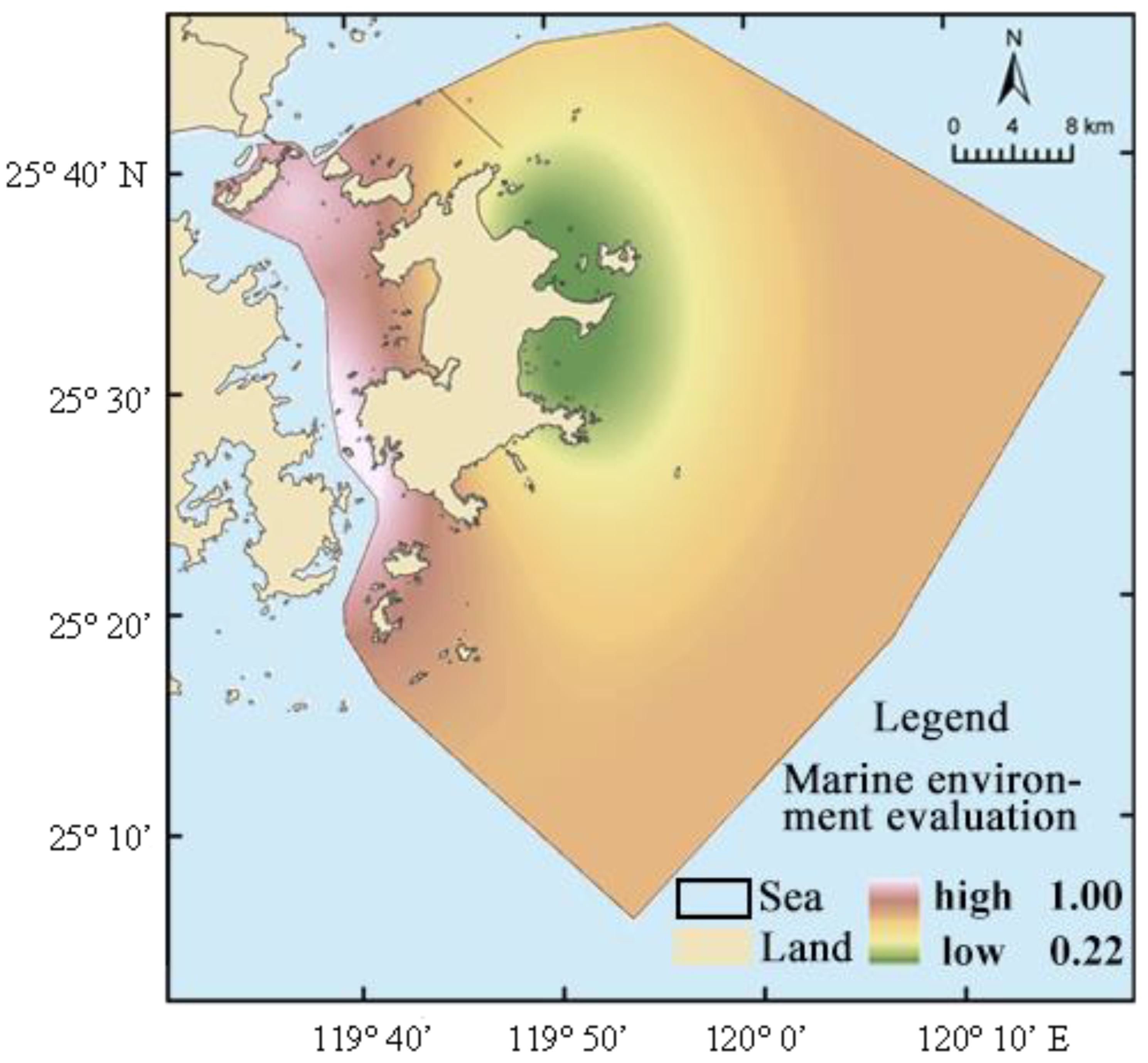
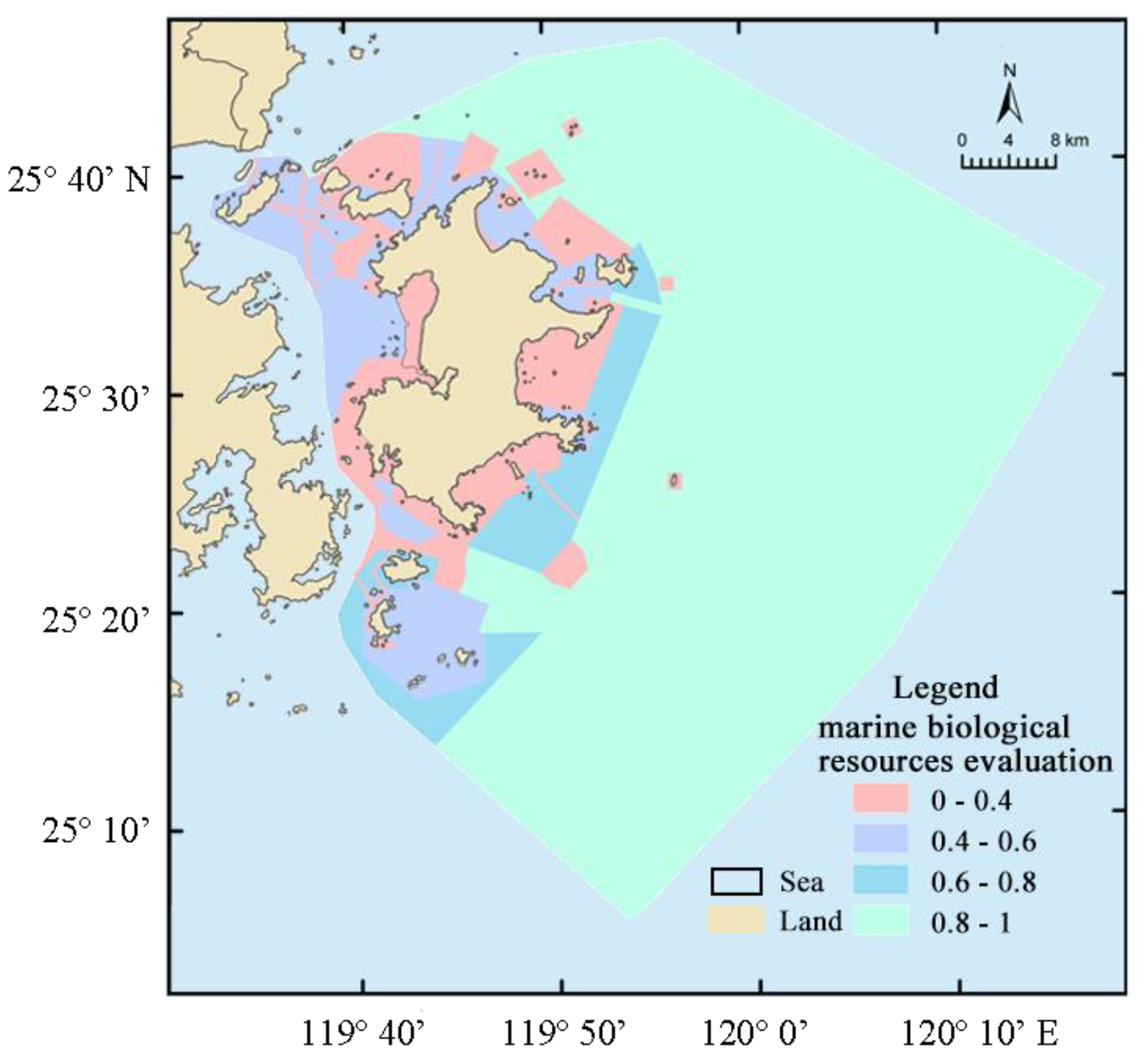

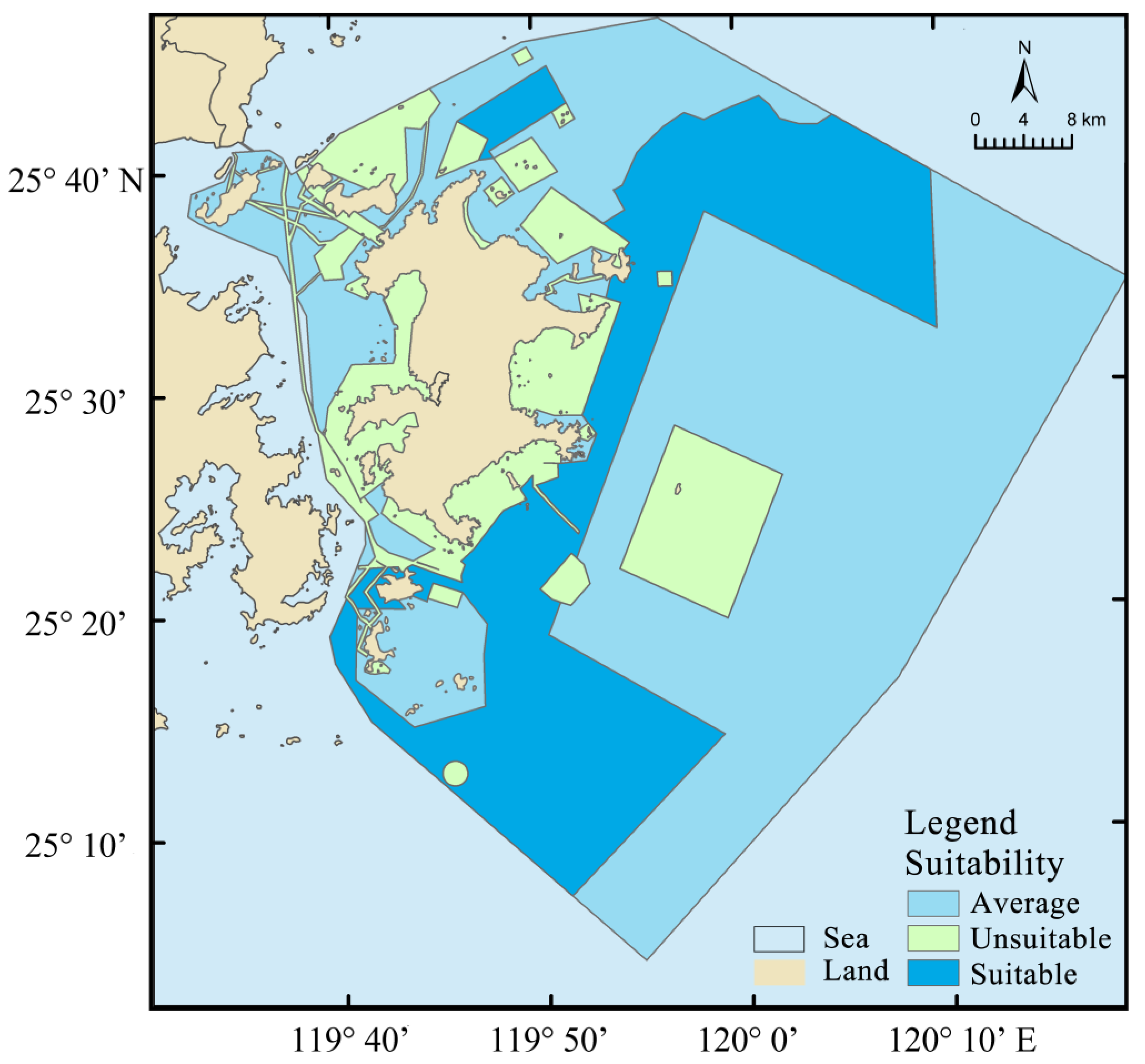
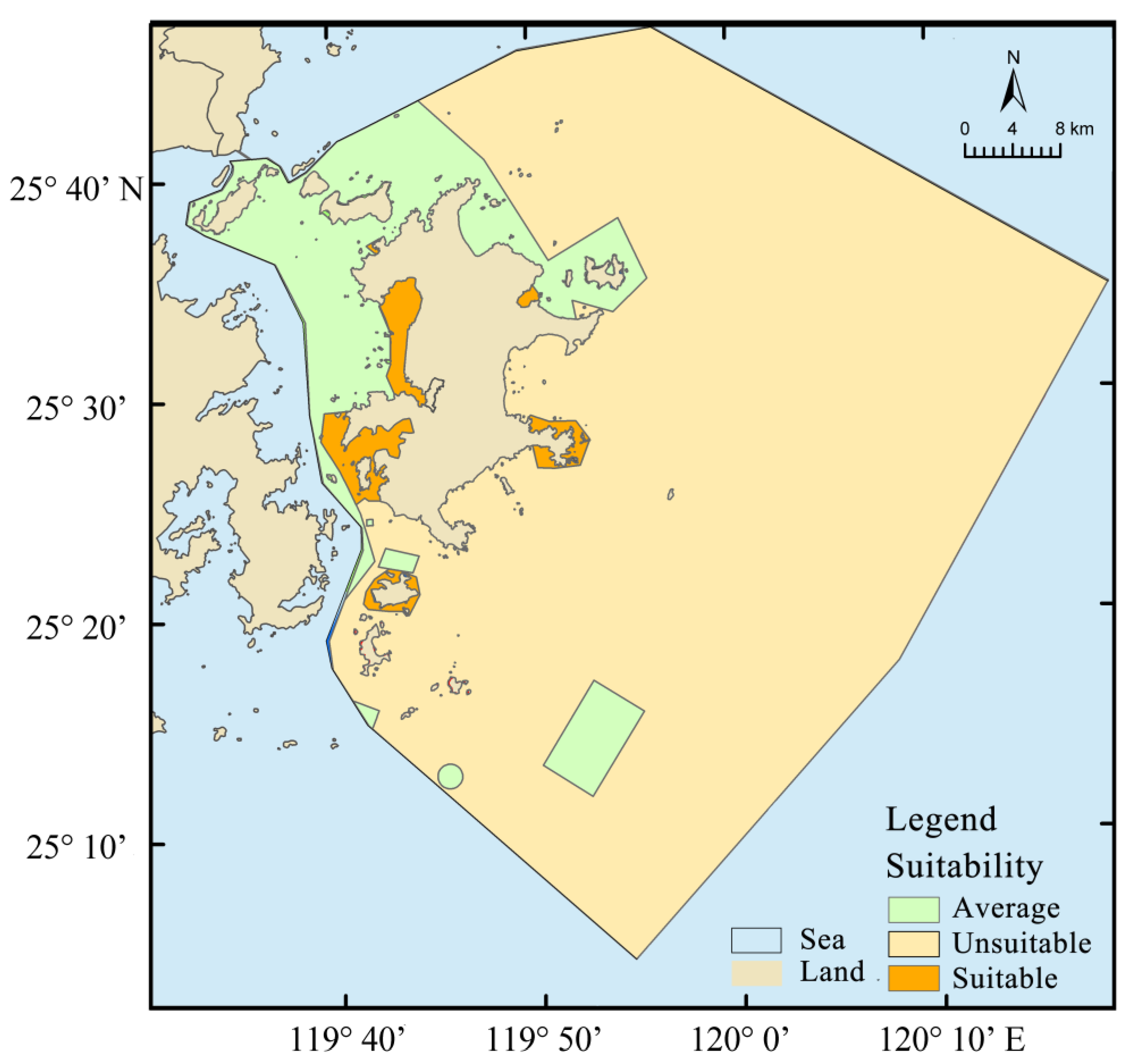


| Theme | Criteria | Explanation |
|---|---|---|
| Marine ecological suitability (G1) | Marine resources evaluation (G11) | Resource effect index |
| Marine environment evaluation (G12) | Water quality | |
| Marine town construction suitability (G2) | Evaluation of marine space resources (G21) | Shoreline development intensity |
| Sea area development intensity | ||
| Marine resources evaluation (G22) | Resource effect index | |
| Development effect index | ||
| Dominance of maritime traffic (G23) | Offshore distance | |
| Suitability of marine agricultural production (G3) | Evaluation of marine biological resources (G31) | Marine biological resources evaluation index |
| Marine environment evaluation (G32) | Water quality | |
| Marine resources evaluation (G33) | Resource effect index | |
| Development effect index |
| Type of Marine Functional Areas | Consumption Coefficients |
|---|---|
| Marine areas for industrial and town development | 1 |
| Ports and shipping area | 0.8 |
| Mineral and energy area | 0.6 |
| Agricultural and fishery area | 0.6 |
| Area for tourism, leisure and creation | 0.4 |
| Area for special utilization | 0.2 |
| Marine protected area | 0.2 |
| Reserved area | 0.2 |
| Primary Sea Use | Secondary Sea Use | Influence Coefficients |
|---|---|---|
| Sea area for industrial use | Sea area for shipbuilding | 1.0 |
| Sea area for solid mineral exploitation | 0.2 | |
| Sea area for other industries | 0.2 | |
| Sea area for submarine engineering | Sea area for cable duct | 0.6 |
| Sea area for transportation | Sea area for ports | 0.8 |
| Sea area for roads and bridges | 0.4 | |
| Sea area for tourism and recreation | Sea area for tourism infrastructure | 1.0 |
| Special sea use | Sea area for coastal protection engineering | 0.1 |
| Sea area for scientific research and teaching | 0.5 | |
| Sea area for fisheries | Sea area for open cultivation | 0.8 |
| Sea area for sea enclosing cultivation | 0.8 | |
| Sea area for fishery infrastructure | 1.0 | |
| Sea area for land reclamation engineering | Sea area for land reclamation of town construction | 1.0 |
| Closest Distance to the Shoreline (km) | 0–6 | 6–12 | 12–18 | 18–24 | 24–30 | ≥20 |
|---|---|---|---|---|---|---|
| Assignment | 1 | 0.8 | 0.6 | 0.4 | 0.2 | 0 |
| Marine Ecological Suitability | Suitability of Marine Agricultural Production | Suitability of Marine Town Construction | Recommended Types |
|---|---|---|---|
| High | * | * | Marine ecological space |
| Medium | High | * | Marine agricultural production space |
| Medium | Medium | High | Marine construction space |
| Medium | Medium | Medium | Marine ecological space |
| Medium | Medium | Low | Marine ecological space |
| Medium | Low | High | Marine construction space |
| Medium | Low | Medium | Marine ecological space |
| Medium | Low | Low | Marine ecological space |
| Low | High | * | Marine agricultural production space |
| Low | Medium | High | Marine construction space |
| Low | Medium | Medium | Marine agricultural production space |
| Low | Medium | Low | Marine agricultural production space |
| Low | Low | High | Marine construction space |
| Low | Low | Medium | Marine construction space |
| Low | Low | Low | Marine ecological space |
Disclaimer/Publisher’s Note: The statements, opinions and data contained in all publications are solely those of the individual author(s) and contributor(s) and not of MDPI and/or the editor(s). MDPI and/or the editor(s) disclaim responsibility for any injury to people or property resulting from any ideas, methods, instructions or products referred to in the content. |
© 2023 by the authors. Licensee MDPI, Basel, Switzerland. This article is an open access article distributed under the terms and conditions of the Creative Commons Attribution (CC BY) license (https://creativecommons.org/licenses/by/4.0/).
Share and Cite
Gao, J.; An, T.; Zhang, H.; Zhang, K.; Shen, J.; He, G.; Yang, X.; Zhao, R.; Tian, S. The Evaluation Method of the Marine Spatial Suitability for Islands from the Perspective of Sustainable Development: A Case Study of the Pingtan Islands. Sustainability 2023, 15, 8996. https://doi.org/10.3390/su15118996
Gao J, An T, Zhang H, Zhang K, Shen J, He G, Yang X, Zhao R, Tian S. The Evaluation Method of the Marine Spatial Suitability for Islands from the Perspective of Sustainable Development: A Case Study of the Pingtan Islands. Sustainability. 2023; 15(11):8996. https://doi.org/10.3390/su15118996
Chicago/Turabian StyleGao, Jinzhu, Taitian An, Hongfen Zhang, Kuncheng Zhang, Jiawen Shen, Guangshun He, Xiao Yang, Rui Zhao, and Shizheng Tian. 2023. "The Evaluation Method of the Marine Spatial Suitability for Islands from the Perspective of Sustainable Development: A Case Study of the Pingtan Islands" Sustainability 15, no. 11: 8996. https://doi.org/10.3390/su15118996
APA StyleGao, J., An, T., Zhang, H., Zhang, K., Shen, J., He, G., Yang, X., Zhao, R., & Tian, S. (2023). The Evaluation Method of the Marine Spatial Suitability for Islands from the Perspective of Sustainable Development: A Case Study of the Pingtan Islands. Sustainability, 15(11), 8996. https://doi.org/10.3390/su15118996






